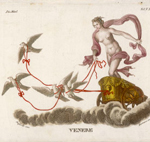AP8 Core Principles VIII
Planets in their Chariots

That stars are said to be in their own chariots when they are in their own domicile or exaltation or confines. For, such a star is mighty even if it is ending its course by arriving under the beams of Helios; and if they are arising or pivotal or look upon Selene, they show the nativity to be authoritative.
Antiochus Summary – TARES Vol 2 (Schmidt trans.)
An outstanding feature that has emerged from the ongoing excavation of astrological heritage is the enhanced awareness of essential planetary dignity. The coherence and relevance of this artful system is represented in the ancient teaching tool of the Thema Mundi, where the soli-lunar relationship and sect appear fundamental to the Art’s symbolic and philosophical depths. Essential Dignity is a bedrock principle for both method and delineation, bringing a cohesive force to the birthchart. Without a good comprehension of this doctrine, astrological ‘language’ cannot be fluently and creatively negotiated with any real substantiation.
This Intensive offers an extensive exploration and application of a central tenet from the astrological heartland – Essential Dignity. The idea relates to a celestial body being placed in a zodiac sign, or in a part of a zodiac sign, which is considered to be natural or familiar territory. Each ‘sign’ (modern term) is actually the ‘house’, or more appropriately the ‘celestial house’ of a planet or light. The meaning, function and capacity of every planet will be conditioned by these various placements, or lack thereof.
The purpose of this dignity (and debility) system is to judge the degree of any planet’s potential for pure (or compromised) archetypal expression. Essential Dignity is to astrology what “times tables” are to arithmetic. It is basic grammar for every astrologer, which needs to become second nature for delineation to be fluent, organic and uniquely meaningful.
Each planet is also said to be in its proper chariot, or throne, or otherwise triumphantly situated, when it holds familiarity with the place that it actually occupies by two, or more, of the prescribed modes of connection: for when it is so circumstanced, its influence and energy are especially augmented by the familiarity it thus holds with the sign which encompasses it …
Ptolemy – Tetrabiblos Book 1 Ch XXVI (Ashmand trans.)
Throughout astrological history the term ‘throne’ is another traditional word used for the chariot concept. Various levels of dignity (domicile, exaltation, triplicity, bounds, and face), or ‘modes of connection’, allow for complex associations, permutations, and algorithms which enrich the whole astrological palette in an extraordinary way.
A warp and weft of interwoven relatedness will allow for delineation to be finely calibrated and individualised to every particular context – central to all this is the keynote principle of Astrological Reception. One celestial body, in another’s zodiacal image, will be ‘received’ by the lord of the sign, via domicile, exaltation, triplicity, bounds, or face – the exact degree and aspect depending.
The Essential Dignity system and Reception are also used in techniques at other sophisticated levels – e.g. using bounds for medical/physical delineation, or using triplicities for predictive work, or calculating the planet(s) strongest at a particular degree.
The essential conditions of both dignity and debility are baselines which further call the challenge of the true ‘art’ of ‘astrological judgment’ to the forefront – where all has to be carefully weighed, with a technical and creative ‘call’ being made by the practitioner.
This intensive (AP8) was first presented in Brisbane(QFA) in September 2009 and on the Gold Coast(GCAS) in November 2009.
Contact the Astrology Project – Join the mailing list for regular information on Intensives and topics of astrological interest. Email: